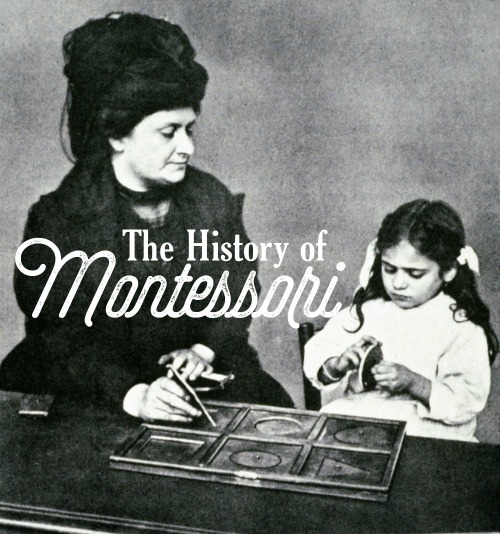 Welcome! I’m glad you’re back. We’re just beginning a year-long series called Montessori 101: Your Introduction to Montessori Education. We’re going to be looking at the basics of the Montessori method.
Welcome! I’m glad you’re back. We’re just beginning a year-long series called Montessori 101: Your Introduction to Montessori Education. We’re going to be looking at the basics of the Montessori method.
But before we dive in, I think it’s important we learn about the woman the name Montessori and how the Montessori method came to be.
Who was Maria Montessori?
 Maria Montessori is best known as the founder of the Montessori Method. A woman ahead of her time, determined and unflinching against society’s conventions.
Maria Montessori is best known as the founder of the Montessori Method. A woman ahead of her time, determined and unflinching against society’s conventions.
Montessori was born on August 31, 1870 in Chiaravalle, Italy. As a young child, Maria was eager to learn and was encouraged by her mother to pursue her scholastic endeavors, even though her father didn’t want her educated beyond secondary schooling.
At 13, Montessori entered an all-boys technical school in preparation for becoming an engineer. After technical school she continued pursuing her dream of becoming an engineer. Later she entered the University of Rome La Sapienza Medical School in pursuit of a medical degree.
Montessori’s greatest challenge in medical school was being in a male-dominated field regularly disrespected by her peers and forced to dissect cadavers on her own at night (due to university policy). Montessori persevered and became the first female doctor in Italy. She would work in various positions that would shape her future: pediatrics, psychiatric clinics, and hospitals (one for children).
After graduating from the University of Rome, Maria worked at the university’s psychiatric clinic, often visiting children in the general insane asylums of Rome. During these visits, she was convinced even these children, who were considered “mentally deficient” and cast aside by society, could be educated.
Montessori went to London and Paris to study the works of Jean Itard and Edouard Ségun, both who became great early influencers of the Method, in hopes of finding a better way to care and teach these children. (Itard & Segun studied and researched the cognitive processes in children with intellectual disabilities.)
How was the Montessori Method developed?
In 1896, Maria gave a speech at the Educational Congress in Torino on her findings from working with these children. The Minister of Education was in attendance and intrigued by Montessori’s discoveries appointed her as director of Scuola Ortofrenica, an institution devoted to the care and education of the mentally disabled. Her two years there Montessori considered her real training, observing the children, testing hypotheses, and building materials. She came to this conclusion,
“I felt that the methods which I used had in them nothing peculiarly limited to the instruction of idiots. I believed that they contained educational principles more rational than in use, so much more so, indeed, that through their means an inferior mentality would be able to grow and develop. Thus feeling, so deep as to be in the nature of an intuition, became my controlling idea after I had left the school for deficients, and, little by little, I became convinced that similar methods applied to normal children would develop or set free their personality in a marvelous and surprising way.”
-Maria Montessori, The Montessori Method, 33
Success came when a few of her students took the state examinations for reading and writing and passed with above-average scores. Montessori saw this and thought that if these methods brought mentally disabled children to the level of normal children, then, she wondered, how it would increase the potential of normal children. She would soon have her chance to find out.
Not long after this discovery became known, Montessori was asked to start a school in a housing project in Rome. The children ran free and, oftentimes, were destructive while their parents were at work. The developers saw Montessori as an opportunity to reign in the unruly children and save their housing project.
The school opened in San Lorenzo on January 1907 and was called Casa dei Bambini, or Children’s House. Montessori gave the children an opportunity to learn by teaching them everyday chores to puzzles and other interesting constructive activities. Montessori’s time at Casa dei Bambini also allowed her to further observe and develop her method.
Montessori built a natural environment for the children, one in which “everything is suitable for his age and growth, where possible obstacles to his development are removed, and where he is provided means to exercise his growing faculties” (Lillard, Montessori: A Modern Approach, 4).
 Montessori was surprised by how happy and satisfied the children where when concentrating on a task of interest, even repeating it over and over. Children learned by doing things themselves, correcting their own mistakes, having freedom to chose their work and materials, as well as not receiving a reward or punishment for their efforts. She found the students didn’t care about rewards and if they were rewarded often ignored the prize or gave it away. She believed the children were searching for a sense of personal dignity and found it in work.
Montessori was surprised by how happy and satisfied the children where when concentrating on a task of interest, even repeating it over and over. Children learned by doing things themselves, correcting their own mistakes, having freedom to chose their work and materials, as well as not receiving a reward or punishment for their efforts. She found the students didn’t care about rewards and if they were rewarded often ignored the prize or gave it away. She believed the children were searching for a sense of personal dignity and found it in work.
She also learned that children prefer order, responsibility in regard to their environment, doing real-life work with real materials, working in quiet, and learning socially acceptable personal care. She respected the child and believed in his or her capability.
As news of Montessori’s school and its results spread, people became more and more interested in Montessori and her method. So Montessori began giving lectures, writing pamphlets and later books, and even going on to give teacher training courses in the method.
Montessori continued experimenting with her philosophy, discovering children’s needs and abilities, and creating an environment and materials to bring about the child’s full potential.
In her later years, Montessori traveled extensively throughout Europe, India, and even to America giving lectures, teaching training courses, visiting schools, and displaying her classroom’s at exhibitions. She received many honors and was even nominated for the Nobel Peace Prize three times. She also received numerous honors and titles throughout Europe. In the year before her death, she taught her last teacher-training course and spoke at the International Montessori Council (IMC), having lived through two world wars many of her talks focused on educating children to live peaceably.
Montessori gave the world a new way to educate children, a way that brought life and discovery to learning.
Are you new here? Welcome! We’ve just started a year-long series—Montessori 101! Sign up for the Our Montessori Home Newsletter and you won’t miss a post! Find out more about the series.































1 comment… add one
Thank you so much for doing this series! I wondered if you might comment on some ways for me to help my 2.5 year old girl extend her focus. It seems like she pays attention and is engaged in what she’s doing for about 2 minutes and then is “all done!” And wants to move on to the next thing. She is also adverse to playing or doing activists by herself. I don’t know if I just don’t give her interesting things or if it’s just her age, but I wonder if I’m not doing something right and setting her up for a short attention span forever. Any thoughts are greatly appreciated!
Thanks
Carrie